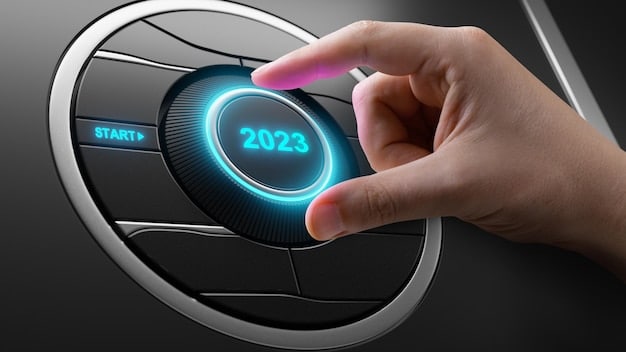US Energy Star Appliance Standards Update: What to Know for 2025

Navigating the updated US Energy Star appliance standards effective January 2025 requires understanding key changes in energy efficiency criteria, testing methodologies, and the overall impact on consumers and manufacturers.
As we approach 2025, it’s crucial to understand the significant updates to the US Energy Star appliance standards. These changes impact everything from manufacturing to consumer choices, shaping a more sustainable future for our homes and the environment. This article breaks down what you need to know about the updated US Energy Star appliance standards effective January 2025.
Understanding Energy Star and Its Importance
The Energy Star program, managed by the US Environmental Protection Agency (EPA) and the Department of Energy (DOE), is a voluntary labeling program designed to identify and promote energy-efficient products. But why is this important? Let’s delve into the basics of Energy Star and its critical role in promoting sustainability.
What is Energy Star?
Energy Star was established in 1992 to reduce energy consumption and greenhouse gas emissions by identifying top-performing, energy-efficient products. These products undergo rigorous testing to ensure they meet strict energy efficiency guidelines set by the EPA and DOE.
Why is Energy Star Important?
The Energy Star program benefits consumers, businesses, and the environment. For consumers, Energy Star-certified products offer significant savings on utility bills and contribute to a more comfortable living environment. Businesses benefit from reduced operating costs and enhanced corporate social responsibility. Environmentally, Energy Star helps lower greenhouse gas emissions, conserve natural resources, and reduce pollution.
- Energy Savings: Energy Star products use less energy, directly translating to lower utility bills for consumers.
- Environmental Protection: By reducing energy consumption, these products help decrease greenhouse gas emissions and conserve natural resources.
- Performance Standards: Energy Star certification ensures that products meet high standards of energy efficiency without compromising performance.
Ultimately, Energy Star serves as a trusted symbol for identifying products that are both environmentally friendly and cost-effective. This helps consumers make informed decisions that benefit their wallets and the planet.
Key Changes in the 2025 Energy Star Standards
The 2025 updates to the Energy Star appliance standards include several key changes affecting a wide range of appliances. These changes are designed to further improve energy efficiency and align with technological advancements. Here’s a breakdown of the major updates.
Refrigerators and Freezers
Refrigerators and freezers are among the most energy-intensive appliances in a home. The 2025 standards introduce stricter efficiency requirements, focusing on improved insulation, more efficient compressors, and better temperature management.
Washing Machines and Dryers
For washing machines, the new standards emphasize reduced water and energy consumption per load. Dryers will see improvements in moisture sensing technology to prevent over-drying, saving energy and prolonging the life of clothes.

- Stricter Efficiency Metrics: Appliances must meet higher energy efficiency ratings to qualify for the Energy Star label.
- Advanced Technology Integration: The standards encourage manufacturers to incorporate the latest energy-saving technologies.
- Revised Testing Methodologies: New testing procedures will more accurately reflect real-world energy usage.
These changes collectively ensure appliances not only meet but exceed current energy efficiency expectations, further reducing energy consumption and promoting environmental sustainability.
Impact on Appliance Manufacturers
The updated Energy Star standards significantly impact appliance manufacturers, requiring them to innovate and adapt their products to meet the new criteria. This can involve substantial investments in research and development, as well as modifications to existing manufacturing processes.
Research and Development Investments
Manufacturers need to invest in R&D to develop new technologies and designs that meet the stricter efficiency standards. This includes exploring advanced materials, improving insulation, and optimizing appliance performance.
Supply Chain Adjustments
Adjustments to the supply chain are also necessary. Manufacturers may need to source new components that are more energy-efficient, which can require finding new suppliers and renegotiating contracts.
For manufacturers, compliance with the updated Energy Star standards is both a challenge and an opportunity. It requires significant investments and adjustments but also fosters innovation and enhances the competitiveness of their products.
Benefits for Consumers
Consumers stand to gain significantly from the updated Energy Star appliance standards. The most immediate benefit is reduced energy consumption, leading to lower utility bills. Over the lifespan of an appliance, these savings can add up to a substantial amount.
Lower Utility Bills
Energy Star-certified appliances use less energy, which directly translates to lower electricity and water bills. This can free up household budgets and reduce the financial burden of running essential appliances.
Increased Product Lifespan
Many Energy Star appliances are designed with durability in mind. Improved components and better engineering can extend the lifespan of these products, providing long-term value to consumers.

- Cost Savings: Reduced energy consumption leads to lower monthly utility bills.
- Reliability: Energy Star appliances often have extended lifespans due to higher quality components.
- Environmental Impact: Consumers contribute to a greener planet by using less energy and reducing their carbon footprint.
The updated Energy Star standards empower consumers to make informed purchasing decisions that benefit their wallets and the environment. By choosing certified appliances, households can enjoy long-term savings and contribute to a more sustainable future.
How to Identify Energy Star Appliances
Identifying Energy Star appliances is straightforward, thanks to the program’s clearly marked labels. These labels are designed to be easily recognizable and provide essential information about the product’s energy efficiency.
Look for the Energy Star Label
The Energy Star label is the primary indicator of an appliance’s energy efficiency. It is usually prominently displayed on the product packaging, and the appliance itself. The label features the Energy Star logo and may include additional information about the appliance’s energy performance.
Check the EnergyGuide Label
In addition to the Energy Star label, many appliances also feature an EnergyGuide label. This label provides detailed information about the appliance’s energy consumption, allowing consumers to compare the energy efficiency of different models.
Visit the Energy Star Website
The Energy Star website offers a comprehensive list of certified products. Consumers can search by appliance type, brand, and model to verify if a product meets Energy Star standards. The website also provides valuable resources and tips for saving energy at home.
By using these simple methods, consumers can confidently identify Energy Star appliances and make informed decisions that align with their energy efficiency goals.
Future Trends in Energy Efficiency
The future of energy efficiency is dynamic, with ongoing developments in technology and policy continuing to drive improvements. Several emerging trends are set to shape the landscape of energy-efficient appliances in the coming years.
Smart Home Integration
The integration of smart home technology is becoming increasingly common. Smart appliances can optimize energy usage based on real-time conditions and user preferences. Features like smart thermostats, automated lighting, and energy-monitoring systems help reduce energy waste and improve overall efficiency.
Advanced Materials and Design
Innovations in materials science are leading to more efficient and durable appliances. Advanced insulation materials, lighter and stronger components, and optimized designs contribute to reducing energy consumption and extending product lifespans.
- Smart Technology: Integration of smart features for optimized energy usage.
- Sustainable Materials: Use of recyclable and eco-friendly materials in appliance construction.
- Policy Incentives: Government incentives and rebates to encourage the adoption of energy-efficient appliances.
The trajectory of energy efficiency points towards smarter, more sustainable, and highly efficient appliances. These advancements promise to further reduce energy consumption, lower utility bills, and protect the environment.
| Key Point | Brief Description |
|---|---|
| 💡 New Standards | Stricter efficiency requirements for various appliances in 2025. |
| 💰 Cost Savings | Reduced energy consumption leads to lower utility bills for consumers. |
| 🌍 Eco-Friendly | Lower greenhouse gas emissions and conservation of natural resources. |
| ✅ Identifying Appliances | Look for the Energy Star label and EnergyGuide label on products. |
Frequently Asked Questions (FAQ)
▼
The Energy Star program is a US initiative to promote energy-efficient products, helping consumers save money and protect the environment through reduced energy consumption.
▼
The updated Energy Star appliance standards are scheduled to take effect in January 2025, influencing manufacturing and consumer choices from that date forward.
▼
Consumers will benefit from lower utility bills due to reduced energy consumption, as well as the potential for increased reliability and lifespan of appliances.
▼
The updated standards affect a variety of appliances, including refrigerators, freezers, washing machines, and dryers, all aimed at improving overall energy efficiency.
▼
You can find more information on the Energy Star website, which lists certified products and offers resources for saving energy at home, empowering informed decisions.
Conclusion
Understanding and adapting to the updated US Energy Star appliance standards effective January 2025 is essential for manufacturers, consumers, and the environment alike. By embracing these changes, we can collectively contribute to a more sustainable and energy-efficient future.





